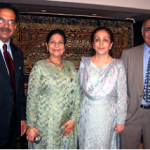The Washington Diplomat
The Washington Diplomat
By Gail Scott
August 14, 2007
Pakistan’s Sadequain: Reminiscent of Picasso
In celebration of Pakistan’s 60th anniversary of independence, Ambassador Mahmud Ali Durrani and his wife Fatima hosted an exhibit of paintings and calligraphy by their country’s most famous artist, Syed Sadequain Ahmed Naqvi (1930-87). Popularly known as “Sadequain,” he is regarded as one of the finest painters and calligraphers that Pakistan has ever produced.
The exhibit was mounted by his eldest nephew, Salman Ahmad, who fondly remembers painting as a young boy with his uncle and has now left a successful business in information technology to create a foundation to honor his uncle’s work.
From left, Mr. and Mrs Salman Ahmad, and Mrs. and Ambassador of Pakistan Mahmud Ali Durrani stand in front of Pakistani artist Syed Sadequain Ahmed Naqvi’s most famous designs, which has been made into a rug.
“Le Monde called his work reminiscent of [Pablo] Picasso,” Ahmed told the crowd gathered at the Pakistani Embassy. “And the New York Times said that he was a new personality in the art world. But Sadequain has no gallery, no museum, and I want to make sure he and his work are not forgotten.”
Sadequain is thought to have finished thousands of canvases, numerous poems and poetry books, and reams of sketches. Ahmad hopes to create a living memorial to his uncle, who was known for giving his work away. “The family has some of it, but we want to raise funds to be able to one day gather his work together in a permanent exhibit,” Ahmad noted.
Sadequain is especially remembered for his huge, historic murals and avant-garde sketches of men and women with modern, more Western themes. Although born in India, Sadequain moved to Karachi in the early 1950s. Soon, civic activism was the hallmark of his art. During his early work, he painted nationalistic, anti-British slogans on the eve of the partition. Later, his politically charged canvases became popular among the intelligentsia of the 1960s, both in Pakistan and abroad.
Sadequain, an award-winning artist, was uninhibited in his use of subjects and media. Lately, even his sketches have sold for over $100,000 in Europe and the U.S.A., according to his nephew.
“He could have lived anywhere in the world,” concluded his proud relative. “And I want to make sure everyone knows about his vast talents and huge body of work. I hope through my foundation’s website to hear from people who appreciate his work and want to be part of making his work better known.”
For more information, visit www.sadequainfoundation.com, or to contact Salman Ahmad, call (858) 538-1574 or e-mail sadequanfoundation@gmail.com.














